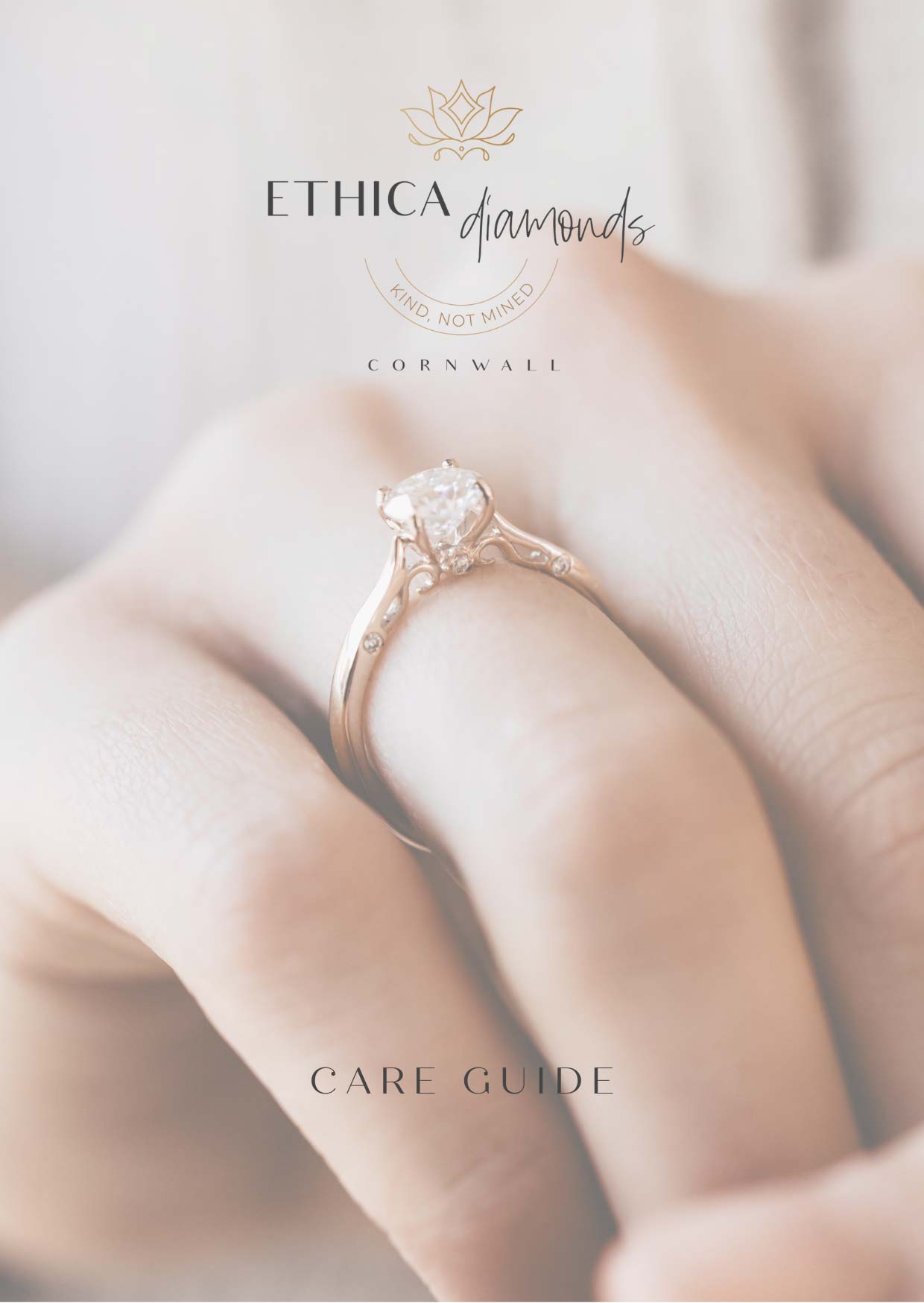What Are Meleé Diamonds?
Meleé diamonds are the unsung heroes of the diamond industry. While some people call meleé diamonds “diamond chips”, jewellery and gemstone professionals appreciate both the great effort that goes into the making of these small diamonds, as well as the value they can add to a piece of fine jewellery.
These stones are often used to accentuate a single centre gem on an engagement ring and are also called accent diamonds that are found on a lot of rings and pieces of jewellery. A meleé diamond is very small and so not much on its own. However, a group of meleé diamonds clustered together can add a stunning sparkle to an otherwise plain ring, giving it more presence and a significantly more impressive appearance.
Meleé diamonds are like the bridesmaids to the bride, the chorus line to a Broadway show or a side dish to a holiday meal. They are there to draw attention to the star of the show, adding intrigue and interest — but never detracting from the main event.
Gemological Institute of America (GIA)
What Does Meleé Mean?
The term Meleé comes from the French word Mêlé for mixed, referring to a group of small diamonds (pronounced mel-ee and not mell-ay) which. Simply put, the word “meleé” here refers to the fact that meleé diamonds are typically sold in bulk with lots of little diamonds mixed together. While meleé diamonds come from all over the world, India, as one of the world's largest diamond producers, accounts for more than 90% of the production market.
So, How Small is a Meleé Diamond?
These small accent diamonds can actually vary quite a bit and officially, the Gemological Institute of America (GIA) defines meleé diamonds as diamonds that are between 0.07 and 0.2 carats. While this is the biggest meleé diamonds get, they can come as small as 0.001 carats, (less than a millimetre in diameter) and the largest meleé diamonds reaching 0.18 carats in weight (close to 4 millimetres in diameter). Larger meleés are obviously more expensive, but smaller meleé diamonds have plenty of uses as well and they too can create beautiful pavé, vintage, and designer look settings.
They are inexpensive compared to larger stones, and they can be generously added as dazzling accents in jewellery and watches. Their brightness and scintillation enhance the centre stone in a halo-style ring or create intricate patterns in a pave-set design. Often cut as round shapes, they are also available in fancy shapes, such as emerald, pear, princess, radiant and marquise.

The Different Shapes of Meleé Diamonds
Most people think that meleé diamonds are always round, and other shapes are often not considered meleé diamonds. However, there are variants of meleé diamonds including:
1. Small Round Meleé Diamonds:
The classic round shape is also the most prevalent one. It has a myriad of accent uses whether in a pavé or halo setting, or any other.
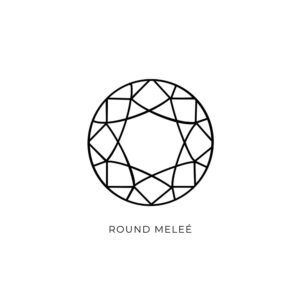
2. Princess Cut Meleé Diamonds:
You’ll sometimes find little square-shaped meleés on jewellery, giving the piece a more contemporary and edgy appearance.
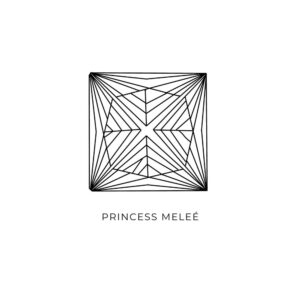
3. Tapered Baguette Meleé Diamonds:
This unique trapezoid shape is great for following the curve of a piece of jewellery and fits well inside stone or three-stone settings.
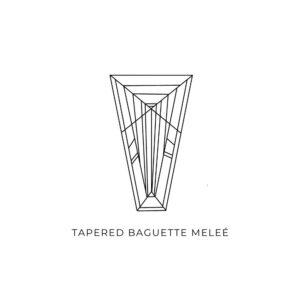
4. Straight Baguette Meleé Diamonds:
Similar to tapered baguettes, straight ones are almost perfectly rectangular in shape. They are used in accents to provide symmetry and tend to appear larger than they actually are. These are often seen in diamond set wedding bands.

Tips for Buying a Diamond Ring With Meleé Diamonds
More often than not when choosing a ring, there won’t be much opportunity to customise the meleé diamonds used for your purchase. However, you should still be sure the meleé diamonds on your ring are a high enough grade, or it may end up detracting from the centre stone and can look a completely different colour.
The central stone has a grading report, but the lesser diamonds that surround it do not and because of this, some retailers may make false claims about the meleé diamonds used in their jewellery, and use low-quality diamonds to cut down on their cost. At Ethica, we only use the highest quality E-F VVS meleé diamonds that are grown utilising renewable energy, so you can be assured that they will perfectly match your chosen centre diamond.
Try to ensure that the meleé diamonds don’t overshadow the centre stone because although meleé diamonds can give an exquisite shine to your ring, you usually want the attention drawn to the larger diamond in the middle.
Also, consider that meleé diamonds are more prone to becoming dislodged and need more day to day care. A ring with a lot of small diamonds will need regular maintenance over time. We offer an annual maintenance service to keep your ring in tip top condition.
Are Meleé Diamonds Worth Anything?
As with larger diamond cuts, the price of a meleé diamond depends on the quality of the cut and the size of the diamond. As meleé diamonds are much smaller diamonds, they are not valuable individually.
Meleé diamonds are rarely, if ever, sold individually or commercially. They are usually bundled in parcels containing hundreds of small diamonds and sold wholesale to jewellery designers or repairers. The price of meleé diamonds is then calculated by total carat weight of the parcel, rather than for each individual stone.
Meleé diamonds commonly cost between £300-400 per carat, for stones with an average grade. Higher graded diamonds, such as those with VVS/VS in clarity and higher than H or I in colour may cost up to £1,000 per carat. As the size of the diamond diminishes, the price per carat decreases, therefore tiny meleé diamonds will cost a fraction of this sum.

Are Meleé Diamonds Real?
A common question that pops into a lot of people’s heads is:
Are these small chips even real diamonds?
And that’s an understandable question given the small size of meleé diamonds. The fact of the matter is that, unlike big diamond centre stones where you are given specifics about the stone’s cut, colour, clarity, or carat (the 4Cs), most retailers, as we discussed earlier in this article, won’t give you such choices when it comes to the meleé diamonds in your jewellery and is often set with lower grade quality stones.
This, however, doesn’t mean that meleé diamonds aren’t real but is just a consequence of their small size and the resulting economics of meleé diamonds.
How Can I Tell If The Meleé Diamonds in my Ring are Natural or Laboratory Grown?
In short - you can't. De Beers has announced to launch a new screening device for easier and faster verification of meleé diamonds. That will make it easier to verify which diamonds are lab-grown or natural even in the smallest size of 0.001ct. However, the challenge for the jewellery trade: it is quicker and cheaper to grow small diamond crystals, so meleé-size laboratory-grown and simulated diamonds are abundant in the market. Given their small size and the large number of loose stones in a parcel, laboratory-grown and treated or simulant meleé diamonds can be mixed in with natural diamonds — and missed.
GIA addressed this challenge in 2016 with a meleé analysis service for round diamonds, the most common shape of meleé, an automated system that analyses and sorts meleé-sized diamonds quickly and accurately. The goal of the automated process is to minimise the percentage of natural diamonds that will be referred for further testing.
“The best instrument will pass 100 percent of natural diamonds, with 100 percent laboratory-grown and simulants referred for further testing,” said Tom Moses, executive vice president and chief laboratory and research officer. “No single instrument in the world, however, can pass 100 percent of natural diamonds, because there is always a small percentage of natural diamonds that show similar features to lab grown or treated stones.”
Meleé Diamond Ring Settings
Meleé diamonds are used in ring settings to provide dazzling sparkle, fire and brilliance to an engagement ring.
Popular ring settings with meleé diamonds include pavé, halo and channel settings. Meleé diamonds are perfect to add volume and all-round shine, without taking away from the diamond at the centre.
They are also often set around the centre diamond in a halo setting such as our Mina design. A halo setting is a great way to accentuate the size of a centre stone, without paying a premium for a high-carat diamond.

To give you an indication of just how little these diamonds weigh, have a look at our Leyna ring setting. Notice that the total CTW is surprisingly only 0.50 carats. The overall look appears expensive and sparkly and full of diamonds. You would never have guessed just by looking at it that the carat weight of the meleés are actually so low compared to how large the ring looks.

Another example is our Eugenie design. The meleé is only an additional 0.27 CTW but the ring is full of beautiful sparkle.

Taking Care of Meleé Diamonds
If you do decide to opt for an engagement ring with meleés, note that the major downside of such accent stones is that over time with wear and tear, they tend to get dislodged or loose as they can catch on clothing and are generally more susceptible than a single solitaire. To avoid this happening, ensure that you take care of the ring well and accept that there will be more maintenance on these designs to check the integrity of the piece and to fix any loose stones it might have.
It is also more difficult to clean jewellery with meleé diamonds, as there are more nooks and crannies where dirt can get lodged. We don’t recommend using ultrasonic cleaners as the shock of the vibrations can cause meleé diamonds to work loose. It’s best to simply use a mild liquid soap, like washing up liquid and very warm, recently boiled water with a soft brush to remove any dirt and grime out of the setting.
Click the image or click here to read our care guide.
In Summary
Hopefully, we’ve shown you why meleé diamonds deserve more love and appreciation than they usually get. These small wonders may be cheaper than the popular larger round diamonds and they may be less captivating at first glance but they serve a vital purpose in every piece of jewellery.
Read Next

Inside Taylor Swift’s Engagement Ring (and How to Get the Look for Less)
Taylor Swift is officially engaged - and her breathtaking vintage engagement ring has everyone talking. Featuring an 8-carat old mine cut diamond in an antique Georgian-inspired setting, the ring is estimated to be worth over $550,000. But for fans who adore the timeless style without the price tag, Ethica Diamonds offers stunning lab-grown alternatives, including bespoke replicas for a fraction of the cost. Discover everything about Taylor’s engagement ring design, price, and how you can get the look ethically and affordably.

Dua Lipa’s Engagement Ring & The Rise of Chunky Band Rings in 2025
Dua Lipa’s bold engagement ring has set the tone for one of 2025’s biggest jewellery trends - chunky band engagement rings. Her 2 carat diamond on a thick gold band breaks away from tradition, inspiring brides to embrace statement-making designs that reflect their personal style. From wide cigar bands to sculptural solitaires like our Dillon Ring, Ethica Diamonds explores why chunky engagement rings are rising in popularity, the difference between thin and thick bands, and how to choose the perfect style for you.
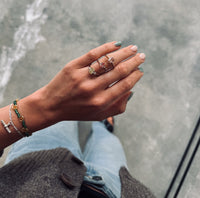
Colour is the New Classic: Engagement Ring Trends to Watch
This summer, coloured engagement rings are taking over. Discover why modern couples are choosing lab-grown stones for their ethical beauty, individuality, and timeless charm.

